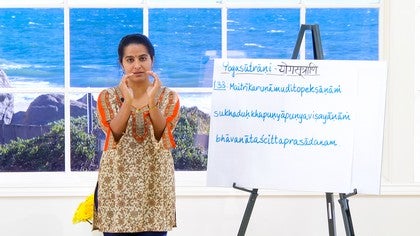Description
About This Video
Transcript
Read Full Transcript
Namaste friends. We've had a very very exciting journey with studying Sanskrit together and I sincerely hope that you're enjoying every step on that way. It would be nice at this stage to have a look at what the words that we've been using like Namaste, Dhanya Vada, thank you. What do they look like? So here I'd like to share with you the writing of those words. So the most popular word that we all use is Namaste. Let me write it out for you. Namaste. As you'd already be aware of this word is composed of two words Namaha Te. Namaha meaning salutations and Te is you. So this greeting is actually a salutation to you. You might sometimes wonder that the person you're saluting need not always be worthy of the salutations that you're offering. Well the deeper philosophy of Namaste helps us to meet that problem, meet that challenge in a meaningful manner. So this Te or you that they're referring to is not just your outer personality with all its limitations. It refers to the divinity within you. So every time one says Namaste it is an acknowledgment of that underlying divinity in that individual. So in a sense when two people say Namaste they are two godheads in recognition of each other's divineness or divine quality. So we'll write that out in the Devanagari script as well. Na, Ma, S and Th with the symbol a. You would notice that it's the dental Th and therefore it has to be Namaste and not just Namaste just a small note. So Namaste. The next one that we've been looking at quite a lot is the word Swagatam. So when you meet somebody it would be natural to say Namaste and then Swagatam or welcome. So let's see what it looks like. Swagatam. We've been practicing these with our previous sessions. So the S is again like in the Namaste, the half S plus the V plus the vowel a. G. Complete and again we have the Th. Th and then because it's half the sound. So Swagatam. There you are. Swagatam. So normally when you meet a person you say Namaste, Swagatam and then what you would want to find out how that person has been. So you can say kushalam. Just the tone kushalam with the question mark is good enough. So kushalam. Ku, Sha, Lam. Kushalam. You can add Va or Kim which means is everything kushalam.
So kushalam and in Sanskrit it would be the letter k with the vowel uf. Then it's the palatal sh, kush, and then the l. You remember the McDonald's loving it. Looks like the M. So there you go. Kushalam. There you go. Kushalam and the answer preferably is aam which is yes or no. Na. Write it out. Aam. You can even say aam asti. Asti means is. So all is well. So is well. So aam or I'll say the asti. So you could say aam asti or aam kushalam asti. So I'll just mark that as a possibility of saying aam kushalam asti. Okay and let's see how that's written. Aam and asti. Remember because it was a short e it has to come before. So you have to plan a little bit for it in advance. So aam asti or aam kushalam asti. Asti meaning is. So yes it is. Just aam asti. Yes it is. And if life has not been too good with you that day you could probably say na kushalam nasti. So that would be na which is no. I'll just leave that gap for the kushalam nasti. There. And if you have to write it in Sanskrit it would be like that. The letter na kushalam na aa. Just same as that. So have that line before nasti. There you are. Okay so when you meet somebody namaste swagatam kushalam kim or kushalam vah or just kushalam is good. Aam kushalam asti or nam kushalam nasti. Often we also use the term okay which is astu. Let's write that down. Astu which means so be it. It's actually a form of the word asti. But in the imperative it says so be it. Astu. So asta and u. Here it combines with the vowel e. Here we have the vowel u. Astu. And personally I like to believe that when you say astu as a result of the creative power of the Sanskrit language you actually start make things happening. How's that? Now so astu. And then you have a whole conversation. We are not yet there to have the whole conversation in Sanskrit but when we get there at the end of it you would like to thank the person. So you say dhanya vah daha. Dhanya vah daha. And this is how it would be said. Dhanya vah daha. And in Sanskrit we would write it as dhanya vah daha. Dhanya vah daha. The answer to that can be astu dhanya vah daha. Or Swagatam welcome some people say that or astu dhanya vah daha. Just a small note on the word dhanya vah daha which is very beautiful I think. The word dhanya comes from the root dhanam or the word dhanam which means wealth. So dhanya is this experience of feeling wealthy and vah daha is saying that. So when someone receives something from you they feel wealthier and therefore they would say dhanya vah daha.
The answer is astu dhanya vah daha. May your wealth increase or so be it may you be more wealthy. And that is I think is quite important in terms of what it offers to the person who is helping because what it says is that I have given something and the person has wished me more wealth so that I can be a greater giver. So dhanya vah daha and astu dhanya vah daha. Be a giver and be a greater giver and wealthier by receiving. The next one is when you are parting and you want to say punar mila maha. Punar mila maha is written like this. Punar mila maha. Punar means again and mila maha means we'll meet. So we'd write it like that. Now we have a combination there of this is a complicated combination. You have r, m and e. So because we have the vowel e it has to come before so you have to plan for it. So you put the stick you have the vowel or you have the consonant r which becomes like an r on top. So you have to write the letter m and the r. So it's punar and then you have to complete the mi and love for loving it and maha. Punar mila maha. And as you part you want to wish well to the person who's leaving. So you would say shubham astu. It's again the word astu you would recognize and shubham means may well being be yours. So shubhamastu. It's a combination of shubham and astu. So you could sometimes even just say shubham. Shubham means well being. May good happen. So just may good. And that would be written as shubhamastu. There we are. So would you like to say that once with me namaste swagatam kushalamvah or kushalam kim am kushalam asti na kushalam nasi or just na is enough then astu so be it. Dhanya vah daha. Thank you. The answer to that astu dhanya vah daha. As you leave punar mila maha. Again we'll meet and to wish the person well shubham astu or shubham. So punar mila maha and shubham astu. So we saw the basic words that we use in Sanskrit that we can use in our daily lives. I thought another useful thing to teach you before we continue further is to know how to introduce ourselves. So I'll tell you my name in Sanskrit and then I'll ask you yours. mama nama anuradhah. mama nama anuradhah. mama nama anuradhah. Now if you were a man I would ask you the question which is a respectful question. bhava taha nama kim. bhava taha nama kim and the answer would be mama nama peter john rama shiva anything. So I'll start it again. I will say the answer and then I'll ask you the question especially if you're a man because for the woman the question would be a little different. So if you're a man answer mama nama anuradhah. mama nama anuradhah. bhava taha nama kim. You got it? Great. Now let's see what the question is to a woman. For a woman the question would be bhava taha nama kim. bhava taha nama kim. Again bhava taha nama kim and the answer mama nama kira or mama nama kristan, mama nama radhah. If you want to play and I ask you the question in a masculine way, you give me a masculine answer because you see at the end of the day we all have both aspects of the male and the female within us. So it depends which name we want to identify ourselves with. It can be a game. So we'll play this game. I'll say my name and I'll ask you yours and depending on the question you answer correctly. mama nama anuradhah. mama nama anuradhah. bhava taha nama kim. bhava taha nama kim. Did you give a man's name at the end? You did? Great.
Another way I use to help us remember this bhava taha is that it has a little of the male energy you know. So bhava taha nama kim. Very macho like. Okay. You want to try that? bhava taha nama kim. Kim is what? Right? Now the other one bhava taha nama kim. bhava taha nama kim. And the answer? Yeah? Give a lady's name? Uttamam. Excellent. So we have the questions bhava taha and bhava taha. Just as a joke I normally share with my students I say that when you see a woman what happens? Your jaw drops and your breath leaves you breathless. So you can remember it as bhavatya nama kim. And the masculine name is bhavat, moh macho. Okay. And the answer is mama nama. I'll just write that out for you so you have your own records for this. So the question for a man, bhava taha nama kim. And that is for the man. I'll just write an m to indicate it's a man. Okay. bhava taha nama kim. And if you were I will also write that in Sanskrit which is bhava taha nama. Notice that there is no there is a line across while there is no there. And then the short e so the line before kim.
And the answer mama nama. I'll stick to the Indian names now it might be just easier. So mama nama shiva. mama nama shiva. You would normally say shiva ha. It's fine. So in Sanskrit or in the Devanagari it would be mama nama. There is a short e so the stick comes before shiva ha. And we put a full stop. And the question to a lady was bhava taha nama kim. It starts more or less the same way. I'll write an f to indicate it's a lady. bhava nama kim. And in the Devanagari script it would be bhava taha yaha nama kim. And the answer mama nama kira. mama nama kira. kira. And that in the Devanagari would look like this. mama nama. Because it's a long e so it comes afterwards. rah and then ah kira. There you are. So you got that? We just say it once again. bhava taha nama kim. What is your name? For a man? The answer mama nama shiva ha. If you want to ask a lady bhava taha nama kim, answer mama nama kira. I always encourage you to use your hands because that way you teach your body the language as well. A last way of asking this question which is more friendly and which doesn't depend on the gender of the person you're asking it to is tava nama kim. So I'll just put that out in the thing without the answer because the answer you can just fall back on what we have seen. tava nama kim. And that is we have the letters tava nama kim. There you go. uttamam. So once you've introduced yourself in Sanskrit you would see that you'd start feeling different. I'm joking. But enjoy this process of speaking in Sanskrit. I tell you it is such a joy. If I can just share with you a small experience that I had. I was travelling from one camp to another in India and Sanskrit camps and I ended up spending a whole month only speaking Sanskrit. It was a complete Sanskrit immersion. I was listening to Sanskrit, talking in Sanskrit, dreaming in Sanskrit and then I shifted to another camp where I had to speak English. Now after having spoken one month of Sanskrit and being immersed in those sounds, when I started speaking English it was almost as if the sounds of this language were coming out from the tip of my tongue. It is not to have any lack of respect for the language because every language is beautiful.
Every language has its own power and its own beauty. What I'm just trying to show through this example is what I experienced regarding the power of the sounds on the body itself. And I know that it has been in my life a very important way of feeling a joy without any need for any external things. Just the nature of this language is joyful if one knows how to study it in the spirit of the language. So open your hearts, speak Sanskrit and you'll be happy. Dhanya Vadaha. Punar Mila Maha.
Mother Tongue: Sounding the Words
Comments
You need to be a subscriber to post a comment.
Please Log In or Create an Account to start your free trial.










